The aromatherapy market is experiencing steady growth driven by increasing consumer inclination toward wellness, stress management, and holistic healing. Rising awareness about the therapeutic benefits of essential oils and natural fragrances has boosted adoption across both household and commercial settings. Current market trends indicate expanding product innovation, enhanced product availability through e-commerce platforms, and the integration of aromatherapy into spa, wellness, and healthcare facilities.
Manufacturers are focusing on sourcing purity, sustainable production methods, and regulatory compliance to ensure quality and consumer trust. The future outlook is supported by growing interest in preventive healthcare, the influence of lifestyle changes, and the increasing popularity of complementary therapies.
Market growth is being further reinforced by product diversification and strategic marketing emphasizing mental and physical well-being With expanding applications and technological advancements in formulation and delivery methods, the aromatherapy market is poised for sustained expansion, offering consistent opportunities for producers, retailers, and service providers across global markets.
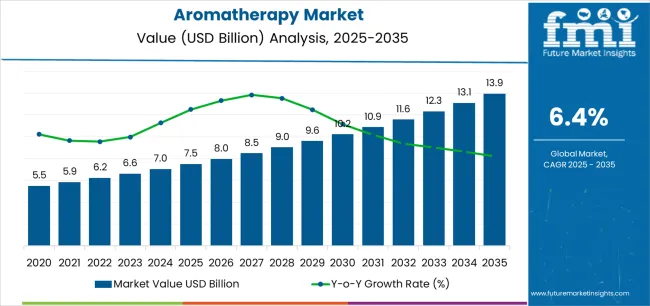
| Metric | Value |
|---|---|
| Aromatherapy Market Estimated Value in (2025 E) | USD 7.5 billion |
| Aromatherapy Market Forecast Value in (2035 F) | USD 13.9 billion |
| Forecast CAGR (2025 to 2035) | 6.4% |
The market is segmented by Product, Application, Mode of Delivery, and Distribution Channels and region. By Product, the market is divided into Aromatherapy Consumables and Aromatherapy Equipment. In terms of Application, the market is classified into Relaxation, Insomnia, Pain Management, Scar Management, Skin & Hair Care, Cold & Cough, and Others. Based on Mode of Delivery, the market is segmented into Topical Application, Direct Inhalation, and Aerial Diffusion. By Distribution Channels, the market is divided into Aromatherapy Products Sold Through Online Channels, Aromatherapy Products Sold At Retail Shops, and Direct Distribution Of Aromatherapy Products. Regionally, the market is classified into North America, Latin America, Western Europe, Eastern Europe, Balkan & Baltic Countries, Russia & Belarus, Central Asia, East Asia, South Asia & Pacific, and the Middle East & Africa.
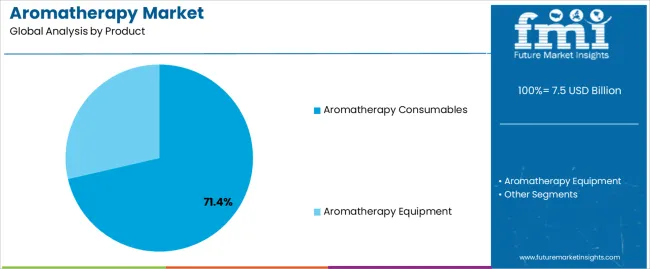
The aromatherapy consumables segment, holding 71.40% of the product category, has emerged as the dominant segment owing to its consistent demand in both professional and personal use applications. This category includes essential oils, carrier oils, and diffusers, which form the core of aromatherapy practices.
Its leadership position is attributed to ease of availability, wide application range, and consumer preference for customizable therapeutic experiences. Manufacturers are focusing on enhancing quality, purity, and aroma consistency, while adopting sustainable extraction and packaging methods to meet evolving consumer expectations.
Continuous innovation in fragrance profiles and functional formulations targeting specific conditions such as stress, fatigue, and sleep improvement is further supporting segmental growth The expansion of e-commerce distribution and brand-driven awareness campaigns has also contributed to sustaining the segment’s market dominance and long-term growth trajectory.
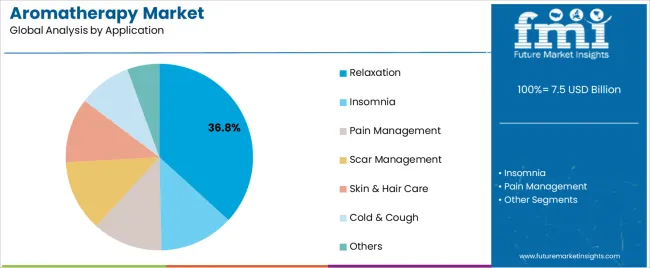
The relaxation segment, representing 36.80% of the application category, has maintained its leading position due to increasing global stress levels and rising adoption of wellness-oriented lifestyles. Demand has been driven by the therapeutic properties of essential oils known to reduce anxiety and promote calmness.
The segment benefits from strong usage across spa chains, wellness retreats, and home-based aromatherapy setups. Growth has been supported by rising awareness of the link between aromatherapy and improved mental health outcomes, alongside expanding research validating its efficacy in mood regulation.
Companies are developing tailored blends that address specific emotional and psychological states, further enhancing consumer engagement The combination of wellness marketing and accessibility through retail and online platforms is expected to sustain dominance of the relaxation application segment throughout the forecast period.
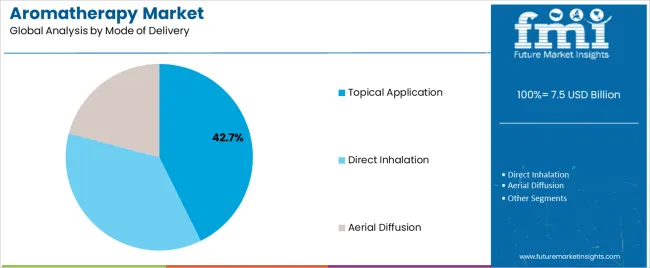
The topical application segment, accounting for 42.70% of the mode of delivery category, has been leading the market due to its direct therapeutic effectiveness and widespread adoption in both professional and personal care settings. Application through massage oils, balms, and lotions allows for enhanced absorption and localized benefits, which has driven consistent consumer preference.
The segment’s growth is further reinforced by increasing demand in spa therapies, dermatological formulations, and home-based relaxation treatments. Continuous innovation in skin-safe blends and organic carrier bases has improved user safety and expanded product appeal.
Brand strategies focusing on packaging convenience, portability, and sensory experience are supporting sustained engagement As consumers increasingly seek natural, non-invasive wellness solutions, topical application remains the most trusted and effective mode, ensuring continued leadership within the aromatherapy market.
Consumables are the products predominantly used in aromatherapy. Topical application is the top mode of delivery of aromatherapy.
Consumables are expected to account for 86.4% of the market share by product type in 2025. Factors driving the growth of consumables in aromatherapy are:
| Attributes | Details |
|---|---|
| Top Product Type | Consumables |
| Market Share (2025) | 86.4% |
Topical application is anticipated to account for 52.3% of the market share by mode of delivery in 2025. Some of the factors for the growth of topical application are:
| Attributes | Details |
|---|---|
| Top Mode of Delivery | Topical Application |
| Market Share (2025) | 52.3% |
Organic products are seeing increasing popularity in the Asia Pacific and the organic nature of essential oils is thus making the product popular in the region. Availability of a diverse number of plants is also helping the market’s cause in the Asia Pacific.
Growing mental illness numbers in Europe are propelling the market in the region. Rising popularity of alternative medicine is positively influencing the market growth in North America.
| Countries | CAGR (2025 to 2035) |
|---|---|
| China | 9.5% |
| India | 6.8% |
| United Kingdom | 5.5% |
| Germany | 5.9% |
| France | 5.2% |
The market is anticipated to register a CAGR of 6.8% in India for the forecast period. Some of the factors driving the growth of the market in the country are:
The United Kingdom is set to see the market expand at a CAGR of 5.5% over the forecast period. Prominent factors driving the growth of the market are:
The market is expected to register a CAGR of 9.5% in China over the forecast period. Some of the factors driving the growth of the market in China are:
The market is set to progress at a CAGR of 5.9% in Germany for the forecast period. Factors influencing the growth of the market in Germany include:
The market is expected to register a CAGR of 5.2% in France over the period from 2025 to 2035. Some of the reasons for the growth of aromatherapy in the country are:
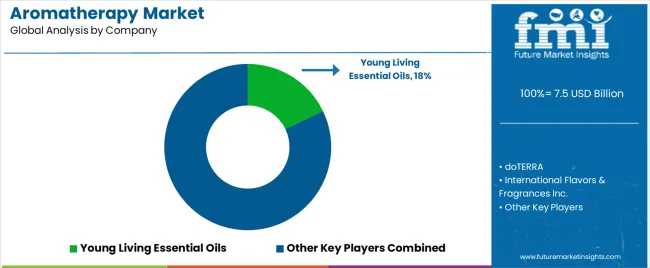
The aromatherapy market is heavily fragmented, with established companies tussling with local players in well-developed regions. The competition in the market is increasing with the experimentation done by market players to achieve dominance.
Market players are expanding geographically to increase market demand. Prominent player doTERRA is taking steps to expand into underdeveloped nations.
Recent Developments in the Aromatherapy Market
The global aromatherapy market is estimated to be valued at USD 7.5 billion in 2025.
The market size for the aromatherapy market is projected to reach USD 13.9 billion by 2035.
The aromatherapy market is expected to grow at a 6.4% CAGR between 2025 and 2035.
The key product types in aromatherapy market are aromatherapy consumables, _essential oils, _blended oils, _carrier oils, aromatherapy equipment, _nebulizing diffusers, _ultrasonic diffusers, _evaporative diffusers and _heat diffusers.
In terms of application, relaxation segment to command 36.8% share in the aromatherapy market in 2025.






Our Research Products

The "Full Research Suite" delivers actionable market intel, deep dives on markets or technologies, so clients act faster, cut risk, and unlock growth.

The Leaderboard benchmarks and ranks top vendors, classifying them as Established Leaders, Leading Challengers, or Disruptors & Challengers.

Locates where complements amplify value and substitutes erode it, forecasting net impact by horizon

We deliver granular, decision-grade intel: market sizing, 5-year forecasts, pricing, adoption, usage, revenue, and operational KPIs—plus competitor tracking, regulation, and value chains—across 60 countries broadly.

Spot the shifts before they hit your P&L. We track inflection points, adoption curves, pricing moves, and ecosystem plays to show where demand is heading, why it is changing, and what to do next across high-growth markets and disruptive tech

Real-time reads of user behavior. We track shifting priorities, perceptions of today’s and next-gen services, and provider experience, then pace how fast tech moves from trial to adoption, blending buyer, consumer, and channel inputs with social signals (#WhySwitch, #UX).

Partner with our analyst team to build a custom report designed around your business priorities. From analysing market trends to assessing competitors or crafting bespoke datasets, we tailor insights to your needs.
Supplier Intelligence
Discovery & Profiling
Capacity & Footprint
Performance & Risk
Compliance & Governance
Commercial Readiness
Who Supplies Whom
Scorecards & Shortlists
Playbooks & Docs
Category Intelligence
Definition & Scope
Demand & Use Cases
Cost Drivers
Market Structure
Supply Chain Map
Trade & Policy
Operating Norms
Deliverables
Buyer Intelligence
Account Basics
Spend & Scope
Procurement Model
Vendor Requirements
Terms & Policies
Entry Strategy
Pain Points & Triggers
Outputs
Pricing Analysis
Benchmarks
Trends
Should-Cost
Indexation
Landed Cost
Commercial Terms
Deliverables
Brand Analysis
Positioning & Value Prop
Share & Presence
Customer Evidence
Go-to-Market
Digital & Reputation
Compliance & Trust
KPIs & Gaps
Outputs
Full Research Suite comprises of:
Market outlook & trends analysis
Interviews & case studies
Strategic recommendations
Vendor profiles & capabilities analysis
5-year forecasts
8 regions and 60+ country-level data splits
Market segment data splits
12 months of continuous data updates
DELIVERED AS:
PDF EXCEL ONLINE
ASEAN Aromatherapy Market Analysis – Size, Share & Forecast 2024-2034

Thank you!
You will receive an email from our Business Development Manager. Please be sure to check your SPAM/JUNK folder too.
Chat With
MaRIA